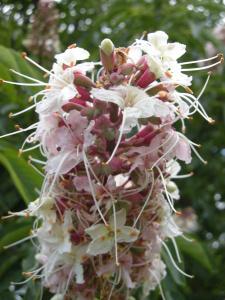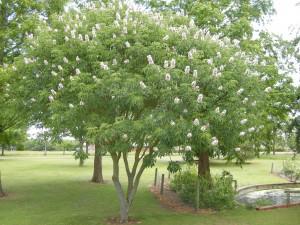
Aesculus californica flower (08/06/2011, Cambridge)
Position: Flourishes in full sun.
Soil: Moist and well drained.
Flowering period: Early spring to summer
Eventual Height: 8m
Eventual Spread: 8m
Hardiness: USDA Zone 7a-8b
Family: Sapindaceae
Aesculus californica is a deciduous tree with a spreading habit. Its foliage is palmately compound, with each simple leaflet being dark green with a serrulate margin. Dense erect panicles of fragrant, sometimes pink-tinged white flowers are borne in early spring and summer. Its fruit is a drooping grey-brown capsule which splits to reveal a bright orange-brown seed in September.
A, californica, commonly known as the Californian Buckeye, is endemic to California although it is currently cultivated in many temperate regions around the world. Traditionally this plant was used by native American tribes, including the Pomo, Yokut, and Luiseño; the plant is highly toxic and was placed in small streams as an aid to fishing, these fish could then be eaten as the poison is not readily taken up in the human digestive system. Its fruit was also eaten when food was scarce once it had been soaked for several days to remove the toxins.
Aesculus is the ancient Latin name for the Horse chestnut, with californica referencing its origins in California.

Aesculus californica (08/06/2011, Cambridge)
This plant may be useful to the landscape architect in soil retention on slopes and banks as it will help bind the soil preventing erosion. Once established this plant is drought tolerant.
This plant will tolerate almost any soil conditions; it will be happy in acid, neutral or alkaline pH levels, in loam, sand, chalk or clay based soils in a sheltered or exposed location facing any aspect.
Ecologically this plant will have a detrimental effect in the UK as not only is it an alien species with no established symbiotic relationships, its nectar is poisonous and will kill most pollinating insects including honey bees.
Maintenance: Requires little to no maintenance, dead or damaged material may be removed at the end of winter.

